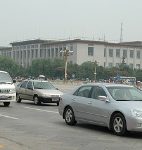The destruction of south China’s wildlife habitats started about 1,000 years ago, and still continues today. This led to many animal extinctions and severe reductions in wildlife populations, and has been compounded by the use of wildlife for food and for ingredients in Traditional Chinese Medicine (TCM).
One might imagine that the pressure on wildlife would have decreased as levels of education and urban incomes have risen in the region. But the greatest reduction in wildlife consumption was actually in 2003, and came as a result of public fears about the risks of catching Severe Acute Respiratory Syndrome (SARS) from wild animals. In late 2004, the demand for civet cats decreased so much due to the fear of SARS that 141 farms released 4,000 of the animals into the wild.
Bird flu later added to this concern.
Many Chinese people believe that eating wildlife is a bad habit, and some will even say it is barbaric, but the practice has persisted in China for around 2,000 years. A 2003 poll taken in Guangdong province found that half of the population had eaten wildlife, snake being named as the favourite of 45% of those surveyed.
With increased affluence in large south China cities such as Hong Kong, Shenzhen, and Guangzhou, greater numbers of well-educated urban men have been reported as travelling to other cities on the Chinese mainland to enjoy feasts of endangered and protected wildlife species – in order to flaunt their wealth. Feast menus typically include cobras and other poisonous snakes, pangolins (a small, scaly animal) and civet cats.
The figures are staggering. Twenty tonnes of snakes and as many as 20,000 birds were eaten every day in Guangdong restaurants in 2001, reported the South China Morning Post. One Guangzhou restaurant, “Chock Full O’Snakes”, served 600 to 700 kilograms of snakes every day throughout January 2001 – the first month of the Year of the Snake. Some wildlife restaurants in Guangzhou can seat as many as 1,000 people.
In 2001, China announced fines of 1,000 to 10,000 yuan for anyone caught eating protected wildlife. But in 2004 Xinhua news agency reported the State Forestry Administration as saying that the cobra population has fallen 90% in the previous decade, while numbers of the common rat snake had dropped 75%. Intense snake hunting in some grain-producing areas of south China has been associated with a rise in local rat populations, which in turn has led to significant loss of grain eaten by the rats.
Wildlife markets obtain their animals from wild-animal farms or from hunters who scour the countryside; and the trade often provides a substantial income to hunters and farmers alike. The South China Morning Post reported that in 2004, civet-cat meat cost around US$16 to US$20 per kilogram in restaurants. Some examples of the wildlife eaten or used as ingredients in TCM include: poisonous snakes (especially cobras), song birds, owls, bear parts, rats, pangolins, elephant “nose”, boas, monitor lizards, tiger parts, crocodiles, monkeys, swans, peacocks, pheasants, civet cats, foxes, emus, Sika deer, leopard cats, mice, centipedes, bats, salamanders, worms, scorpions, beetles and cocoons. Domesticated cats and dogs are another common food source.
Wildlife farming is viewed by researchers at the Animal Institute at the China Academy of Sciences as a way to protect wild animals. They believe that farm-raised animals not only cost less than those that have been poached, but also that they pose less of a health risk. However, they do note that few people cultivate wild animals for its general benefit to society, or as a form of restocking dwindling wildlife populations. Other researchers, at north China’s Jilin Agricultural University, say that any policies focused on raising wild animals should make the protection of wild animals a priority – above and beyond their commercial value.
Wildlife, in its natural setting, benefits society in a variety of ways. For instance, some species carry seeds to degraded land sites and help land restoration. A number of snake species prey on agricultural pests – like rats in grain producing areas – and so help ensure adequate food production. Many species of birds and amphibians also consume mosquitoes, flies and other disease-carrying vectors, thus reducing the risk of human infection. Raising concentrations of wild animals on food farms only has very local benefits; the loss of wildlife from natural habitats will harm society in a great number of ways.
The scarcity of wildlife in Guangdong province, stemming from the high demand for wild animals for food, has meant increasing imports of wildlife from other southern provinces, as well as other Asian countries such as Indonesia, Thailand, Malaysia, India and Vietnam – and even some African countries. These imports increase the pressure on wildlife in these locations.
Smuggling has also become commonplace in nearby Hong Kong, due to the high market value of many endangered or protected wildlife species in mainland China. A look at some Hong Kong police reports highlights the magnitude of the problem: in 2001, the Hong Kong authorities uncovered a shipment of 2.7 tonnes of pangolin scales, a yield that would require the scales of 5,000 to 6,000 pangolins. The next year, crates containing 600 cobras were smuggled into Hong Kong from Malaysia, but were intercepted by the police by a dangerous, high-speed boat chase. And in 2005, a shipment of 1,800 skinned and vacuum-packed pangolins was discovered. The list goes on, and these incidents only represent the tip of the iceberg of the wildlife smuggling trade.
The 2003 SARS outbreak caused widespread concern in China about the possible hazards of eating wild animals. The link between SARS and the handling and eating of certain wildlife was proposed by medical researchers, and the Chinese government closed or relocated a number of wildlife markets, as well as closing many wildlife restaurants. At the height of the outbreak, the Guangdong government banned the breeding, consumption and trading of wildlife. But sales resumed shortly after the SARS crisis had passed. Renewed efforts by the Guangdong health authorities in 2007 to confiscate civet cats led to a haul of 15 civet cats and 22 kilograms of civet-cat cutlets. Health authorities in the Guangdong city of Foshan recently banned the eating of field mice, after vendors were found to have killed the mice with poison before selling them to restaurants.
The China Wildlife Conservation Association, in cooperation with WildAid, conducted a survey in December 2005 and January 2006. The findings were released on April 18 2006, and showed that:
* wild animals were increasingly farmed commercially;
* restaurants that serve wildlife had decreased by 6.6%, but the number of grocery stores selling wild animals had increased by 22.8%;
* the concern over SARS and bird flu was the foremost reason for the drop in animal consumption since 2003;
* around 63% of those people surveyed believed that eating wild animals from illegal sources was not safe;
* of the Guangzhou-based respondents, 70% thought eating wildlife was a potential health risk; and
* of all the respondents, 74% knew that eating wild animals was against Chinese law.
The survey authors said that China needs to reinforce its laws on the elimination of poaching, smuggling and the illegal wildlife trade. An important element of the survey was to identify why people chose to eat wild animals in the first place. These reasons included: health and nutrition (32.4 %); curiosity (31.3 %); taste (27.3 %); and social status (9.2 %). But around 72% of those surveyed said they had not eaten wild animals during the past year. An earlier survey, in 1999, showed that about 40% of those surveyed did not eat wildlife, a proportion which stands at 51.1% today. Overall, the population of south China consumes wildlife to a far greater extent than elsewhere in China.
Although recent evidence suggests that wildlife consumption has slowed, there is also reason to believe that smuggling continues. If something on the scale of a SARS outbreak does not resurface, will the public become increasingly complacent about eating wild animals again? And will environmental education alter people’s eating habits and reduce wildlife consumption? We can only hope, but I am not so certain.
Just prior to the SARS outbreak, I had a conversation with several Chinese ecologists on the subject. Even though these individuals fully understood the damage that was occurring to south China’s wildlife, they told me that when an important, visiting scientist came to dinner, they still would sometimes serve endangered animals to show their high regard for the visitor. Can environmental education and law enforcement make changes to the 2,000 year-old custom of wildlife consumption – in time to avoid further wildlife extinctions? Again, we can always hope.
Walter Parham, Ph.D. (University of Illinois in geology/clay mineralogy) has conducted research part-time in mainland China and Hong Kong for around 40 years. His affiliations include among others the Federation of American Scientists’ director of China Tropical Lands Research, the University of Hong Kong’s Kadoorie Agricultural Research Centre, and the South China Agricultural University in Guangzhou.

